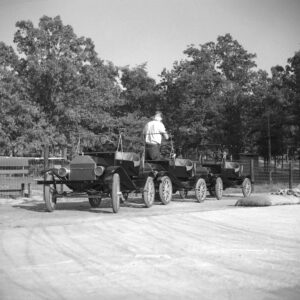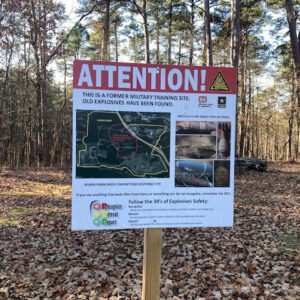calsfoundation@cals.org
Burns Park
Burns Park in North Little Rock (Pulaski County) is one of the largest city-owned parks in the nation. The park acreage has a history of private ownership and subsequently of federal, state, and municipal government ownership. The land has been used over the years for farming, timber, military operations, and a public park.
In 1893, the citizens of Little Rock (Pulaski County) gave a 1,100-acre tract of land north of the Arkansas River to the federal government. In exchange, the thirty-six-acre U.S. Army Arsenal grounds in Little Rock were deeded to the city for use as a public park. The Little Rock Arsenal property at East 9th and Commerce Streets became City Park and was later renamed MacArthur Park in honor of General Douglas MacArthur, who was born at the arsenal in 1880. The property acquired by the federal government north of the river included the area atop Big Rock and additional land to the west. The mountaintop property was used for a small U.S. Army training facility named Fort Logan H. Roots.
In 1917, in response to information that the army was planning to establish a new training camp, the Little Rock Board of Commerce raised $325,000 in public donations to buy additional acreage to give to the government to induce the army to establish the new facility adjacent to Fort Roots. The site was selected, and a 6,000-acre training base was established. It was named Camp Pike in honor of General Zebulon Montgomery Pike, who had first explored the headwaters of the Arkansas River, and was in 1937 renamed Camp Joseph T. Robinson after Arkansas’s recently deceased U.S. senator.
After World War I, the Camp Pike property was turned over to the Arkansas National Guard. The War Department turned the Fort Roots property over to the Public Health Agency in 1921, and in 1922 it was given to the Veterans Affairs Department; the facilities have been continuously used as a veterans’ hospital.
In 1939, with World War II starting in Europe, the U.S. Army was mobilizing and Camp Robinson was federalized. It was expanded to 48,188 acres, and an army basic training camp was established. A 4,000-bed prison camp was added during World War II and housed German prisoners of war. After the war, some of the Camp Robinson acreage was declared surplus property and was sold. The remaining 32,000 acres were returned to the National Guard and are still used in the twenty-first century as its headquarters and training base.
In 1948, the City of North Little Rock learned that the federal government was disposing of some of the Camp Robinson land. Dr. William M. Burns, who had previously served twice as mayor of North Little Rock and was a longtime advocate for creating public parks, urged city leaders to purchase some of the surplus land for a park, as the city then lacked such an amenity. The city therefore acquired 871 acres of surplus property in 1949. Having dedicated the property as a park, the city named it in honor of Burns. A monument in memory of Burns, who died in 1953, was erected in the park.
With the help of Congressman Brooks Hays, in 1955 the city was given an additional 656 adjoining acres of surplus government property. Park acreage grew after the addition of more property from the government in 1976, along with donations from private property owners. Acreage was lost, however, to a power line easement and to the Interstate 40 easement. The park eventually grew to 1,600 acres, the majority of which is still forest. The park extends west to Cook’s Landing Park and the Big Dam Bridge. The southern boundary is the Arkansas River, where it is across from Little Rock’s Murray Park and Rebsamen Golf Course.
Park improvements began in 1950 and have continued. The diverse attractions include fifteen miles of natural-surface multi-use trails, including a horse trail, and six miles of paved multi-use trails. It is part of the bike and pedestrian Arkansas River Trail, which connects the two cities in a large loop. A small amusement park was established after a miniature railroad was added in 1957. Called Funland, it eventually had sixteen children’s attractions such as rides, slides, and a small Ferris wheel. Burns Park also features a camping area, including spaces for fifty-two recreational vehicles, as well as two one-acre dog parks, numerous playground and picnic areas, fourteen pavilions, and a clubhouse.
Sports facilities in the park include an archery range, seventeen soccer fields, twenty-seven tennis courts, twelve pickleball courts, five softball fields, seven youth baseball fields, two regulation baseball fields for high schools, two eighteen-hole golf courses, two eighteen-hole disc golf courses, and three outdoor basketball courts. There is also a fishing lake, river frontage, and a boat launch. Sightseeing features include a covered bridge over the east fork of White Oak Bayou, a Union Pacific Railroad caboose, a World War II army tank, an old log cabin, and an iron jail cell that the city once used.
The cost of operating the park is paid using proceeds from a city advertising and promotion sales tax, supplemented by fees for use of certain facilities.
A tornado devastated the park on March 31, 2023. An estimated 10,000 trees were downed, and many structures were damaged or destroyed, including the whole of Funland, which was still closed at the end of 2023. The park was closed for months for debris cleanup, repairs, and reconstruction. The Federal Emergency Management Agency committed to pay seventy-five percent of the lost value, and the city’s share of the restoration was estimated at $10 million. On December 27, 2023, the North Little Rock City Council voted unanimously to enter into a contract for the rebuilding of Funland.
For additional information:
Eichkorn, Paige. “Burns Park Tennis Facility Back in City’s Hands.” Arkansas Democrat-Gazette, September 25, 2023, pp. 1B, 3B. Online at https://www.arkansasonline.com/news/2023/sep/25/burns-park-tennis-facility-back-in-citys-hands/ (accessed January 3, 2024).
McFadin, Daniel. “NLR OKs Funland Rebuild.” Arkansas Democrat-Gazette, December 28, 2023, pp. 1B, 3B. Online at https://www.arkansasonline.com/news/2023/dec/27/north-little-rock-oks-31m-to-rebuild-reopen-burns/ (accessed January 3, 2024).
Sandlin, Jake. “Burns Park Fixes Lure Golfers to Greens.” Arkansas Democrat-Gazette, May 29, 2017, pp. 1B, 2B.
———. “Burns Park’s M60 Ordered to Roll Out.” Arkansas Democrat-Gazette, June 30, 2018, pp. 1A, 8A.
———. “NLR Adds to Burns Park.” Arkansas Democrat-Gazette, April 9, 2019, pp. 1B, 5B.
Satterfield, W. W. “The Evolution of North Little Rock’s Burns Park.” Pulaski County Historical Review 71 (Winter 2023): 115–120.
W. W. Satterfield
Little Rock, Arkansas
 Recreation and Sports
Recreation and Sports Burns Park Cars
Burns Park Cars  Burns Park Trails
Burns Park Trails  Burns Park Warning
Burns Park Warning 




Comments
No comments on this entry yet.